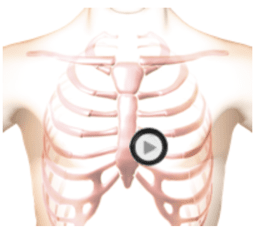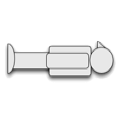Auscultation.
Introduction
We provide training, drills and quizzes for heart, lung and carotid sounds. Our lessons feature an interactive, multimedia approach combining text, audio recordings, waveforms and anatomical animations. In addition, a heart & lung sounds guide provides a quick way to listen to specific sounds.
Definition
Auscultation is the process of listening to body sounds, usually with a stethoscope. Physicians and nurses commonly auscultate the heart and lungs. Abdominal sounds, fetal sounds and carotid bruit can also be auscultated.
Listen
Auscultation can reveal heart murmurs which may be associated with heart valve abnormalities. Heart sounds can indicate congenital heart problems, myocarditis or pericardial friction rub. Listed below are our short courses on heart sounds. Each course can be taken in 15-20 minutes.
Auscultation Example: Wheeze


The patient was supine during auscultation.
Waveform
Respiratory Sounds Reference Guide
Our reference guide provides quick access to this sound as well as many other adventitious sounds. Each sound is described also with an audio recording and waveform.Quick Links to Other Breath Sounds
While we have many breath sound lessons and quick references on this website. Please use the links below.
Bronchial Breath Sounds
Adventitious Breath Sounds
Adventitious Lung Sounds
Wheezing
Rhonchi
Fine and Coarse Crackles
Rales
Egophony
Auscultation Lung Sounds Audio
Related Lessons
| Basics of Lung Sounds
The goal of this basic course in lung sounds is to improve auscultation observational skills. We focus on describing important breath sounds and in providing recordings of each. Many students find that waveform tracings aid in learning lung sounds; we have included dynamic (moving cursor) waveforms with each lesson. The anatomy pages use illustrations to reveal an example of each lung sound (anatomy not yet available on smartphones). |
| 1 | Vesicular - Normal |
| 2 | Crackles - Fine (Rales) |
| 3 | Crackles - Coarse (Rales) |
| 4 | Wheeze |
| 5 | Rhonchi - Low Pitched Wheezes |
| 6 | Bronchial |
| 7 | Pleural Rubs |
| 8 | Bronchovesicular |
| Intermediate Lung Sounds
The goal of this intermediate course is to expand your observational skills when auscultating breath sounds. The course lessons include voiced sounds: bronchophony, egophony and whispered pectoriloquy. We also provide auscultation lessons on several types of wheezes, crackles and stridor. Each of these lung sound lessons includes audio, text and dynamic waveform. The anatomy pages use illustrations to reveal an example of each lung sound (anatomy not yet available on smartphones). |
| 1 | Vesicular - Diminished |
| 2 | Bronchophony - Healthy |
| 3 | Bronchophony - Abnormal |
| 4 | Egophony - e |
| 5 | Egophony - a |
| 6 | Whispered Pectoriloquy - Healthy |
| 7 | Whispered Pectoriloquy - Abnormal |
| 8 | Wheeze - Expiratory |
| 9 | Wheeze - Monophonic |
| 10 | Wheeze - Polyphonic |
| 11 | Crackles - Early Inspiratory (Rales) |
| 12 | Crackles - Late Inspiratory (Rales) |
| 13 | Stridor |
Authors and Reviewers
-
Heart sounds by Dr. Jonathan Keroes, MD and David Lieberman, Developer, Virtual Cardiac Patient.
- Lung sounds by Diane Wrigley, PA
- Respiratory cases: William French
-
David Lieberman, Audio Engineering
-
Heart sounds mentorship by >W. Proctor Harvey, MD
- Special thanks for the medical mentorship of Dr. Raymond Murphy
- Reviewed by Dr. Barbara Erickson, PhD, RN, CCRN.
-
Last Update: 11/10/2021
Sources
-
Heart and Lung Sounds Reference Library
Diane S. Wrigley
Publisher: PESI -
Impact Patient Care: Key Physical Assessment Strategies and the Underlying Pathophysiology
Diane S Wrigley & Rosale Lobo - Practical Clinical Skills: Lung Sounds
- PESI Faculty - Diane S Wrigley
-
Case Profiles in Respiratory Care 3rd Ed, 2019
William A.French
Published by Delmar Cengage -
Essential Lung Sounds
by William A. French
Published by Cengage Learning, 2011 -
Understanding Lung Sounds
Steven Lehrer, MD
-
Clinical Heart Disease
W Proctor Harvey, MD
Clinical Heart Disease
Laennec Publishing; 1st edition (January 1, 2009) -
Heart and Lung Sounds Reference Guide
PracticalClinicalSkills.com
?
main Pv# 1 , InitialPages , pix False , #Drops 0 ;
trys 0